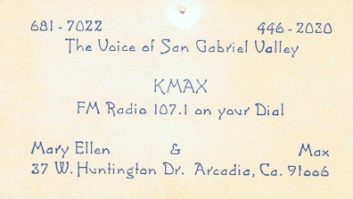There’s a Fine Line Between Streaming and Downloads. New Devices Are Erasing That Line
With vacation season in full swing, many Americans are taking in the unique features of our U.S. landscape -Yellowstone Park … the Grand Canyon … our music licensing rules.
Yes, the U.S. stands practically alone among nations in giving its radio broadcasters access to all published music via so-called “compulsory” or “statutory” license.
This means that there is no requirement for a broadcaster to negotiate with or obtain permission from the rights holder of any musical work before airing it; such rights are stipulated by U.S. copyright law.
There are different versions of this “performance right” license for different types of “broadcasts,” however. Free, over-the-air (OTA) terrestrial radio is exempt from royalties. This allows stations to play any music, any time, with no fees paid to any entity for the right to air the recording. (Under a separate license, there is a small fee paid to the composers of the song, but not to the recording company or performing artists for the right to air the recording of that song.)
Similar compulsory licenses exist for Webcasting (free or subscription) and satellite radio services, but these licenses do include various rates of royalties that the distributor must pay to rights holders for the right to transmit the recording of a song, along with detailed reporting requirements and other logistical details that do not apply to the royalty-free OTA license. All of these licenses are specified in Section 114 of the Copyright Law (U.S. Code Title 17).
Importantly, all of these statutory performance licenses apply only to “broadcast” distribution. If a distributor wishes to sell copies of a recording, the performance right no longer applies, and the prospective seller must negotiate directly with the rights holders for the necessary “mechanical” and other rights.
Upping the ante
Enter satellite radio, which recently has begun to offer a new class of MP3-player/satellite radio receivers that include tens of hours of digital storage capability, but with the additional ability to edit recorded satellite radio streams to save individual songs and discard others.
Because satellite radio broadcasts have always included title-and-artist metadata, this process can be performed by the user by simply scanning and sorting the music-library directory that such a device assembles after recording a portion of satellite radio music programming – perhaps without even listening to the recorded broadcast. Other user features may be available on these devices to aid in the editing and selection of content that is recorded.
As this column has noted previously, the music industry (chiefly via its trade association, the RIAA) sees this new capability as a violation of the terms of the Sec. 114 performance license, which it views as applying only to real-time broadcasts, and not to what it calls “disaggregated, permanent storage” of individual songs. The RIAA feels that the ability to selectively edit and store individual songs from a radio broadcast is tantamount to a music download, and therefore satellite radio should compensate the rights holders of any such music accordingly. This is far from a semantic dispute, since music download services today typically pay about 10 times more per song to rights holders than what Sec. 114 subscription-service licensees pay.
For their part, satellite radio companies respond that this new feature is simply an application of consumers’ fair-use rights to the content they pay to receive with their satellite radio subscriptions – just as with any off-air recording. They add, however, that in these new recorder/receivers, once the device is deauthorized due to the termination of a satellite radio subscription, any songs recorded from satellite radio on the device are automatically deleted. The songs are also limited to playback on the device only, and cannot be digitally copied to a PC or other device, and therefore cannot be burned to CD or redistributed to the Internet.
They also point out (although not as loudly) that the audio quality of the songs is affected by the satellite broadcast air chain – they are recorded in real time off the air – and that if users want high-quality copies of a song, they are directed to online music services to purchase a download (e.g., XM has an arrangement with Napster for such a service).
Further, satellite radio takes pains to point out that unlike download services, recording music via these devices is not a truly interactive process, in that the songs cannot be “ordered,” and listeners have no advance knowledge of if or when a particular song will be played on any given channel. (The devices offered to date include only single tuners, and thus can only record one satellite radio channel at a time, which the listener must select.)
Finally, the satellite radio industry notes that collectively it currently pays more to the music industry via Sec. 114 royalties than any other entity, and that under separate legislation known as the Audio Home Recording Act (AHRA), additional royalties are paid to the music industry for each of the new recorder/receivers sold, as with any audio recording device sold in the U.S. today.
Nevertheless, RIAA has taken a two-track approach against the move, lobbying hard for clarification of Sec. 114 provisions through additional legislation, and meanwhile filing a lawsuit against XM Satellite Radio with high damage claims.
Elsewhere the record industry has suggested other, more tactical solutions, such as requiring devices to record entire radio programs (or at least in no less than 30-minute increments), with no ability for “cherry-picking” of individual songs. Another idea that’s been floated would require the purposeful, randomized offset of title and artist metadata from its corresponding music by a few seconds, thereby making it difficult to select songs and manage libraries using the metadata alone.
Curiouser and curiouser
Aside from the stated positions of the two parties in this process, a number of interesting circumstantial issues will complicate any resolution here.
First, consider that satellite radio is not doing anything different to enable this new service than what they always have done with their transmissions. It is only the receiver functionality that has changed, and these devices are made by third parties. Since satellite radio services are proprietary, however, any receiver maker has established a licensing arrangement, and perhaps even a subsidy or other partnership program, with a satellite radio provider, so the provider can be seen as “complicit” in the new devices’ design. Also, the device-makers aren’t licensing the content – satellite radio is, and it’s the “reinterpretation” of this license by satellite radio operators to include selective storage that music companies are challenging.
Importantly, Sirius Satellite Radio has made an arrangement with RIAA to pay a hefty additional royalty (above the statutory AHRA fee) for each recorder/receiver sold. This deal apparently is what kept Sirius out of the RIAA lawsuit.
In fact, the Sirius approach of paying per device makes some sense, since it would be difficult to assess higher content licensing fees on a per-song basis when only a small (and unknown) percentage of receivers actually stores the content.
Finally, CEA has expressed concern that the RIAA’s proposed legislation and pending litigation could chill manufacturers’ innovation and interest this space.
Perhaps most important for terrestrial broadcasters is that the outcome of this struggle could determine the course that RIAA later takes toward similar devices that can receive and record IBOC signals. So even though the license in question doesn’t apply to OTA radio, the current battle is germane to broadcasters’ future, and well worth continuing observation.









